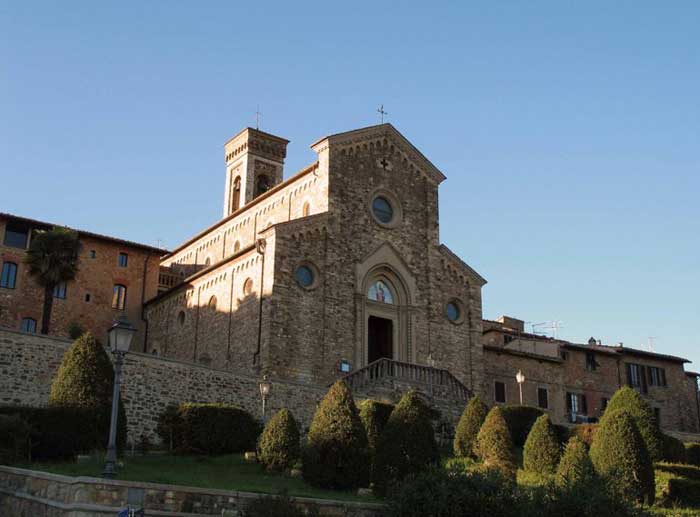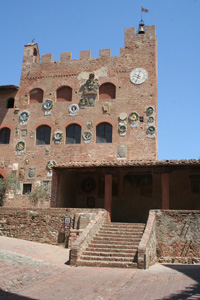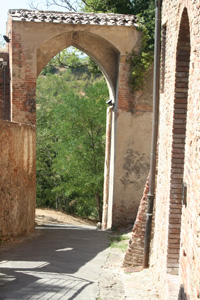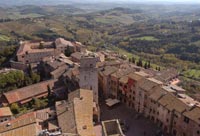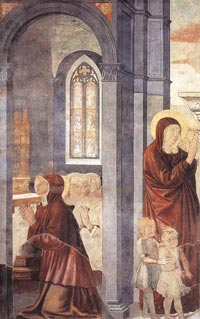Barberino Val d'Elsa |
Halfway between Florence and Siena, on the north-western borders of the Chianti area, a winding hilly road, once the ancient Via Cassia and now State road n° 2, leads up to the town of Barberino Val d'Elsa, situated high up above the valley from which it takes its name. The centre of Barberino Val d'Elsa is still ringed by its original fortifications. The town has retained its mediaeval elliptical shape with a main street running between the two turreted tower gates, the Porta Romana and the Porta Fiorentina. Two other streets run parallel with this main street and meet up with it again near the gates. |
La Pieve di Sant’Appiano (The parish church of Sant'Appiano) |
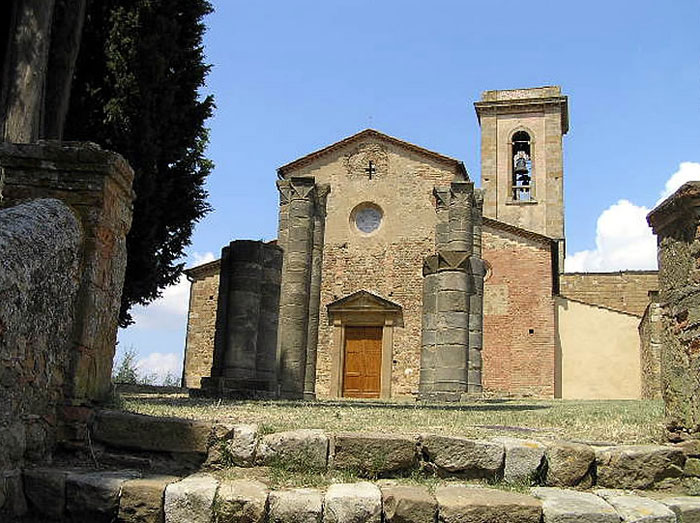 |
La Pieve di Sant’Appiano (The parish church of Sant'Appiano) |
The monumental group of buildings that composes Sant Appiano – the Romanesque Parish Church, the ruins of an octagonal building, the cloisters, the canons' house and the group of houses in the close vicinity forming the village - is situated on a pleasant hill and surrounded by dark cypress trees. The beauty of the landscape blends in perfectly with the sacred atmosphere of this place, which also preserves the remains of the Saint who gave his name to the village, originally called Monteloro.
|
||
View Larger Map |
||
Certaldo |
||
| Site of settlements already in Etruscan times, Certaldo derives its name from the Latin cerrus altus, or from the Germanic cerrus aldo, both meaning “Turkey oak covered height.” Like many other Tuscan towns, Certaldo is divided between its medieval walled town on a hill and the modern residential and industrial suburb spread out below. The square was the main characteristic of medieval towns; all the power centres of the era (religious, political, civil, and commercial) overlooked it. Certaldo grew on an oblong elliptically shaped hill that left no space for the ‘square, whose function was then taken by the present Via Boccaccio which is indeed fronted by the Church, the Palace of the authorities (Palazzo Pretorio), and the Logge del Mercato [Market Halls], now closed. Certaldo’s most representative Monument is the Palazzo Pretorio, or Palazzo dei Vicari located at the top of Via Boccaccio. The Palazzo Pretorio, ancient seat of authority, was built in the 12th century. It was first the residence of the Counts Alberti, then it was expanded and modified to house the functions of the Vicarage: its prisons, audience hall, archives, chapel, and private quarters can still be visited today. There are two large gardens, one of which houses the contemporary artwork The teahouse garden by Hidetoshi Nagasawa. In the Palace and in the adjacent Church of St. Thomas and Prosper, one can admire 15th and 16th century frescoes and sinopias; the Church houses the most important work, The Tabernacle of the Executed (c. 1464/65), a fresco by Benozzo Gozzoli. Originally, this work was located in the plain, near the Agliena stream: those sentenced to death, before their execution, were brought near this frescoed chapel (The Tabernacle of the Executed), where they received the last solace. The chapel is still visible under the bridge, on the right side coming from Poggibonsi. Church of St. Jacopo and Filippo and Romanesque Cloister The Church of St. Jacopo and Filippo goes back to the 12th – 13th century. Inside its single nave, it houses frescoes, sculptures, and glazed terracotta ciboria of the della Robbia School. In the middle, near the bas-relief depicting Boccaccio, is the poet’s tomb. The church also houses the urn of the Blessed Giulia (1319-1367), fascinating legends exist on the life of this figure as a cloistered nun. From the Church one enters the Augustinian Convent with an especially striking Romanesque Cloister that allows access to the Blessed Giulia’s cell, fully preserved through time. Art in Tuscany | Benozzo Gozzolo's Tabernacle of the Executed At the top of Costa Alberti rises the imposing Porta Alberti that, with the Porta al Rivellino and the Porta del Sole, was one of the ancient entrances to the historical Borgo: the present road connecting Upper and Lower Certaldo is, in fact, of recent construction. The Porta Alberti, preserved almost intact, is placed half way up a very steep climb, as imposed by the era’s defensive architecture, so that it would have been extremely difficult to knock it down, even with the aid of battering rams, because of the steep slope. The Porta al Rivellino, which commands a beautiful view of the valley, was the most heavily fortified because it was placed ‘in front of’ the bordering and hostile province of Siena from whose attacks it had to defend itself. Turning right from the Porta al Rivellino, one goes along Via Valdracca that ends at the last of the three old gates: the Porta del Sole, the main one of the Borgo, so called because of its orientation: in its arch are still visible some frescoes that testify to its importance. Above its central arch one can see the coat of arms of the counts Alberti. Certaldo’s Onion The agricultural traditions, the climate, and the hilly environment find expression in a rich production of extra-virgin olive oil and in some labels of Chianti D.O.C.G. wine. Certaldo’s Onion is sought after for its original taste, as well as being representative of the region (it appears on the coat of arms since the Middle Ages). With its intense, slightly sweet taste, it is suitable for soups, and also to make a jam; it is a product certified by a specific mark of quality.[1] Certaldo | Certaldo’s Onion |
||
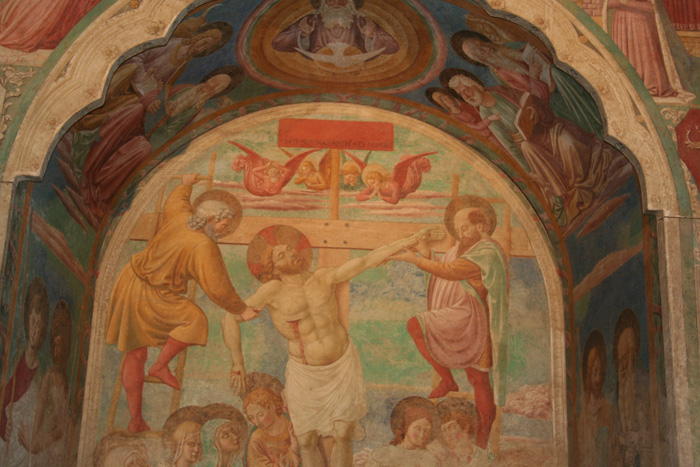 |
||
Benozzo Gozzoli, Descent from the Cross, Certaldo, Palazzo Pretorio, Cappella San Tommaso |
||
| Heading towards Certaldo, we find, in San Donnino, St. Michael Archangel’s cupola, a reproduction ‘in scale’ of Florence’s Duomo, Santa Maria del Fiore. It was built on a design by Santi di Tito in the 16th century in memory of the ancient city of Semifonte, destroyed by the Florentines in 1202. The rivalry between the flourishing Semifonte and Florence is also witnessed by the old saying: “Florence move away, Semifonte leads the way.” |
||
Petrognano The village of Petrognano sprawls along the green hills cultivated with vineyards that lie on either side of the road leading from Barberino to Certaldo. The tiny hamlet is made up of a series of ancient houses, scattered haphazardly around the Villa Capponi. The Morello Tower House is a tower house with outbuildings dating from the 13th century, traditionally believed to having been part of the outer perimeter of Semifonte. Archaeological remains at Petrognano Remains dating from the Etruscan-Hellenistic and Imperial Roman periods were discovered between 1967 and 1968 after excavations were carried out by the Board of Archaeology of Florence. Semifonte |
||
| Petrognano is the village that belonged to a city called Semifonte. Dante mentions it in the 16th canto of the Divine Comedy and he refers to its strong soldiers and wise craftsmen: “Fiorenza fatti in là, Semifon diven città”. The city was surrounded by moats, barbicans, towers and very solid walls. Semifonte was a fortified city in Tuscany, Italy, built during the late 12th century and destroyed after a siege by Florence in 1202. The town was menacing with its power the supremacy of Florence so that was decided to move war against the town. After an epic siege and the bloody final battle of that war, the city surrendered and disappeared with its inhabitants who were sent into exile. To let the people remember the defeat and state the power of Florence on the land a reproduction of the Dome Chapel in Florence was built where once stood the town of Semifonte. Today, very little remains of the city: one truncated tower of the southern gate (Porta San Niccolò) and a nearby chapel, plus various buried remains. These are to be found on the summit of the hill above the village of Petrognano-Semifonte, which dates back to the time of the city and stood outside the walls. In the farm there’s the old parish church of Saint Peter, then reduced to mere chapel. Inside there is still the wood crucifix from the 12th century that is now in the parish priest’s residence in Certaldo. A stone with coat of arms is walled up under the alter. This probably belonged to a valorous defender of Semifonte.
|
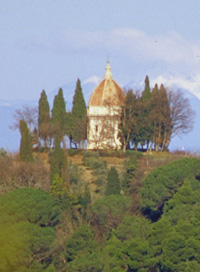 Cupola San Donnino |
|
The Paneretta Castle rises in the territory of Monsanto. It has been constructed around the antique stone tower of the XIII century. This place and the tower itself have always been an important commercial and protective military spot. That's why the tower has started to be surrounded by various buildings, and in the very end it turned out to Castello della Paneretta as we see it today. Paneretta fortress was formerly a simple late medieval stronghold on the border between Siena and Florence with a quadrilateral structure. The first owners of the castle were the family Vettori, the last heir, Maddalena, brought it as dowry to her wedding with Ludovico Capponi in 1577. In 1577 the Paneretta became property of Ludovico Capponi that undertook great works for changing the structure of the castle in country residential villa. The famous Florentine painter Bernardino Poccetti frescoed the courtyard’s loggia, painting the vaults with lively grotesques in late Mannerist taste. Ludovico Capponi also commissioned the building of the little chapel in the garden, which has a simple entrance crowned by a broken pediment. He also commissioned the huge cellars, still in use, whose doors bear the Capponi and the Vettori shields. In 1696, Cassandra Capponi brought the castle an important collection of codex’s parchments and books into her marriage with the Marchese Carlo Riccardi Strozzi. This collection formed the nucleus of the Riccardian library in Florence. The Strozzi family remained owner of the castle until 1984. Since 1984 the Castle and the estate are in property of the Albisetti family. The Paneretta castle is situated on the western slopes of the dominating hills of the Elsa valley, looking towards San Gimignano. Address | Via Paneretta, 19, 50021 Monsanto, Barberino Val d'Elsa San Gimignano |
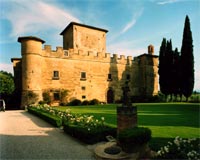 |
|
San Gimignano is mainly famous for its medieval architecture, especially
its towers, which may be seen from several kilometres outside the town.
|
||
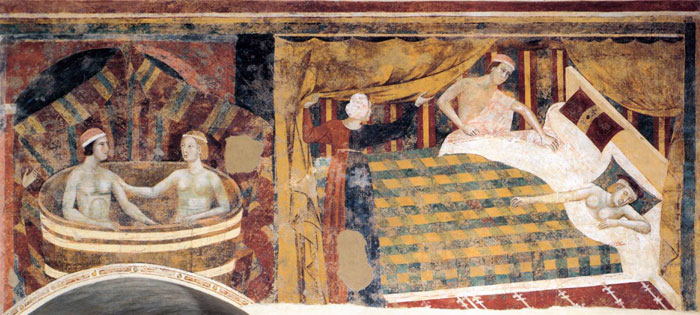 |
||
Memmo di Filippuccio, Erotic scenes, 1300-10, fresco, Palazzo del Podestà, San Gimignano |
||
|
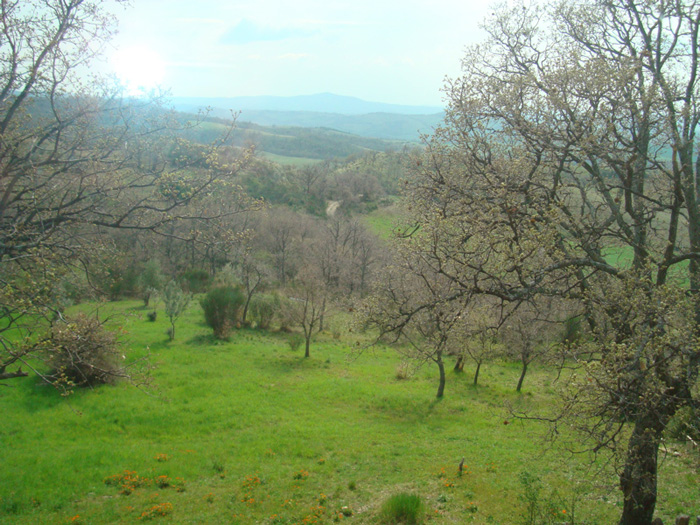 |
Tuscan farmhouses | Podere Santa Pia (view over the southern garden, April ) |
|
| Chianti is a red Italian wine produced in Tuscany. It was historically associated with a squat bottle enclosed in a straw basket, called a fiasco ("flask"; pl. fiaschi); however, the fiasco is only used by a few makers of the wine now; most Chianti is bottled in traditionally shaped wine bottles. Baron Bettino Ricasoli (later Prime Minister in the Kingdom of Italy) created the Chianti recipe of 70% Sangiovese, 15% Canaiolo and 15% Malvasia bianca in the middle of the nineteenth century. The first definition of a wine-area called Chianti was made in 1716. It described the area near the villages of Gaiole, Castellina and Radda; the so-called Lega del Chianti and later Provincia del Chianti (Chianti province). In 1932 the Chianti area was completely re-drawn and divided in seven sub-areas: Classico, Colli Aretini, Colli Fiorentini, Colline Pisane, Colli Senesi, Montalbano and Rùfina. Most of the villages that in 1932 were suddenly included in the new Chianti Classico area added in Chianti to their name-such as Greve in Chianti which amended its name in 1972. Wines labeled Chianti Classico come from the biggest sub-area of Chianti, that sub-area that includes the old Chianti area. The other variants, with the exception of Rufina from the north-east side of Florence and Montalbano in the south of Pistoia, originate in the respective named provinces: Siena for the Colli Senesi, Florence for the Colli Fiorentini, Arezzo for the Colli Aretini and Pisa for the Colline Pisane. In 1996 part of the Colli Fiorentini sub-area was renamed Montespertoli. During the 1970s producers started to reduce the quantity of white grapes in Chianti. In 1995 it became legal to produce a Chianti with 100% Sangiovese. For a wine to retain the name of Chianti, it must be produced with at least 80% Sangiovese grapes.[2] A Chianti may have a picture of a black rooster (known in Italian as a gallo nero) on the neck of the bottle, which indicates that the producer of the wine is a member of the Gallo Nero Consortium, an association of producers of the Classico sub-area sharing marketing costs.[3] Since 2005 the black rooster has been the emblem of the Chianti Classico producers association.[4] Aged Chianti (38 months instead of 4-7), may be labelled as Riserva. Chianti that meets more stringent requirements (lower yield, higher alcohol content and dry extract) may be labelled as Chianti Superiore, although Chianti from the "Classico" sub-area is not allowed in any event to be labelled as "Superiore". The history of Chianti dates back to at least the 13th century with the earliest incarnations of Chianti as a white wine. Today this Tuscan wine is one of Italy's most well known and recognizable wines. In the Middle Ages, the villages of Gaiole, Castellina and Radda located near Florence formed as a Lega del Chianti (League of Chianti) creating an area that would become the spiritual and historical "heart" of the Chianti region and today is located within the Chianti Classico Denominazione di Origine Controllata e Garantita (DOCG). As the wines of Chianti grew in popularity other villages in Tuscany wanted their lands to be called Chianti. The boundaries of the region have seen many expansions and sub-divisions over the centuries. The variable terroir of these different macroclimates contributed to diverging range of quality on the market and by the late 20th century consumer perception of Chianti was often associated with basic mass-market Chianti sold in a squat bottle enclosed in a straw basket, called fiasco.[1] In addition to changing boundaries, the grape composition for Chianti has changed dramatically over the years. The earliest examples of Chianti were a white wine but gradually evolved into a red. Baron Bettino Ricasoli, the future Prime Minister in the Kingdom of Italy created the first known "Chianti recipe" in 1872, recommending 70% Sangiovese, 15% Canaiolo and 15% Malvasia bianca. In 1967, the Denominazione di origine controllata (DOC) regulation set by the Italian government firmly established the "Ricasoli formula" of a Sangiovese based blend with 10-30% Malvasia and Trebbiano. However some producers desired to make Chianti that did not conform to these standards-such as a 100% varietal Sangiovese wine, or all red wine grape varieties and perhaps with allowance for French grape varieties such as Cabernet Sauvignon or Merlot to be used. A few producers went ahead and made their "chianti" as they desired but, prohibited from labeling, sold them as simple vino da tavola. Despite their low level classifications, these "super Chiantis" became internationally recognized by critics and consumers and were coined as Super Tuscans. The success of these wines encouraged government officials to reconsider the DOCG regulations with many changes made to allow some of these vino da tavola to be labeled as Chiantis. Wines in Tuscany | Chianti
|
| [1] Certaldo’s Onion is characterised by a special sweetness and flavour; it is not sharp and its shape is compressed at the poles. It is light purple and has a moist consistency. Certaldo's onion exist in two varieties: the statina is a fresh onion grown in the summer, with a white inside, while the vernina has a dry outside and deep red inside and is for winter use.[Source:Certaldo, a medieval jewel in Tuscany’s green heart | www.toscananelcuore.it] |

